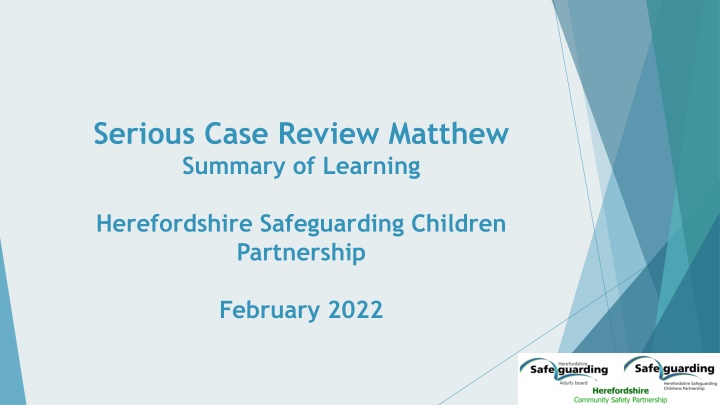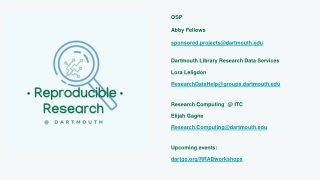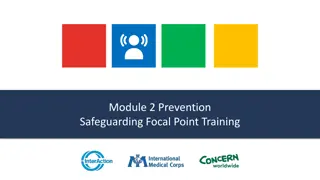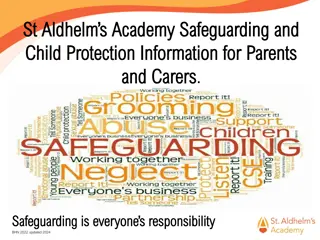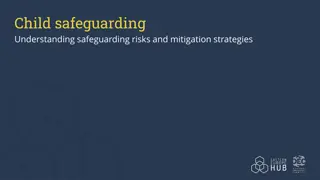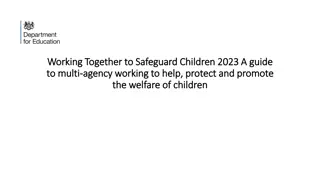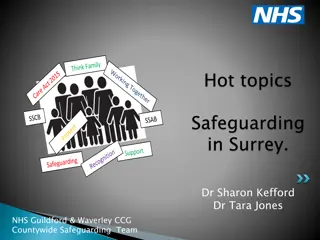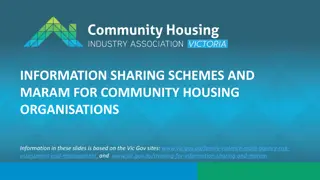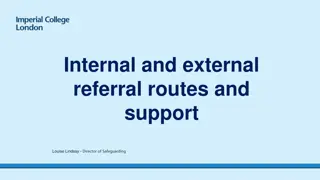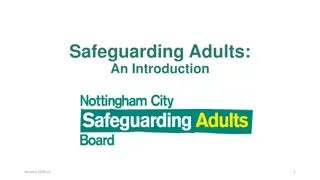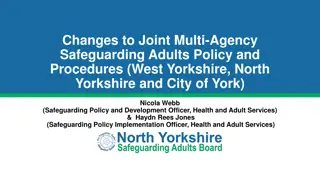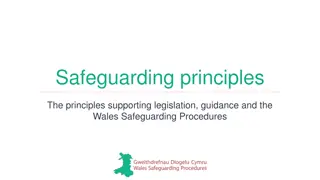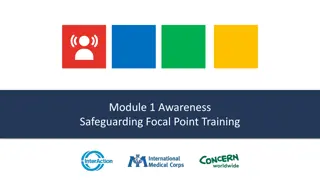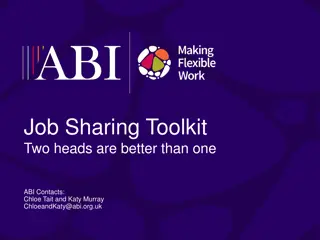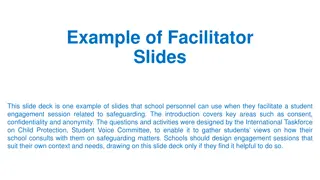Lessons from Serious Case Review: Information Sharing for Safeguarding
Matthew, a child who ingested medication, prompted a Serious Case Review. Key themes identified poor information sharing, ineffective assessment processes, and the engagement of fathers. Lesson 1 emphasizes the importance of proactive information sharing in safeguarding to identify needs, understand risks, and provide appropriate support. The Data Protection Act and GDPR facilitate sharing personal data for safeguarding purposes without always needing consent.
Download Presentation

Please find below an Image/Link to download the presentation.
The content on the website is provided AS IS for your information and personal use only. It may not be sold, licensed, or shared on other websites without obtaining consent from the author.If you encounter any issues during the download, it is possible that the publisher has removed the file from their server.
You are allowed to download the files provided on this website for personal or commercial use, subject to the condition that they are used lawfully. All files are the property of their respective owners.
The content on the website is provided AS IS for your information and personal use only. It may not be sold, licensed, or shared on other websites without obtaining consent from the author.
E N D
Presentation Transcript
Serious Case Review Matthew Summary of Learning Herefordshire Safeguarding Children Partnership February 2022
Background Matthew was one year and seven months old when he ingested medication used to treat psychosis while he was at home in the care of his parents. Matthew lived with his mother and his older sibling. Matthew s father lived locally, however the true extent of the role and involvement of Matthew s father with the family was not known at the time of the incident. Mathew and his sibling were known to a number of agencies and there were concerns of child neglect. There was a history of mental health problems and substance use in the family, and both parents had both suffered early childhood trauma. Matthew s father was known to the police as a prolific offender.
Serious Case Review (Working Together 2015) While Matthew survived the incident, a Serious Case Review (Working Together, 2015) was commissioned due to the significant harm that occurred to Matthew when he ingested the medication. The report was published by the Herefordshire Safeguarding Children Partnership on February 7, 2022 The purpose of Review is to: Establish whether there are any lessons to be learnt from the case Identify what is expected to change as a result of the learning Try to prevent similar incidents from happening in the future NB Under the new Working Together 2018 statutory guidance, Serious Case Reviews are now referred to as Child Safeguarding Practice Reviews, with some changes to the requirements and framework.
Key Themes arising from the SCR Poor information sharing Ineffective assessment, planning and review processes Application of levels of need Broader understanding of risk (especially in neglect and cumulative impact of harm) Understanding of historic issues Role and engagement of fathers Losing focus on children when there are adult issues (offending, substance misuse, mental health) Lack of Professional curiosity Barriers to escalation and professional challenge
Lesson 1: Effective information sharing is essential for safeguarding Be proactive in seeking the right information to assist decision making and to protect children - do not be passive in expecting information to be furnished. Information sharing is essential for early identification of needs, effective assessments, and ensuring the right support is in place Information sharing helps to identify patterns of behaviour that helps to understand risk The Data Protection Act 2018 and GDPR provide a framework for sharing personal information it is not a barrier You do not always need consent to share personal information consent is only one of the lawful basis to comply with the data protection legislation Right Help, Right Time Levels of Need Framework & Working Together 2018 provide clear advice on information sharing for safeguarding purposes
Lesson 2: Behaviour will only be changed by an explicit plan that is monitored and to which there is good adherence Plans should be child-focused, outcome oriented, and SMART: specific, measureable, achievable, realistic, and time-limited Plans should be developed alongside the parents & children/young people, and be written in a child-friendly way. Any plan should be communicated and shared in a timely fashion to all partners, particularly those expected to support and monitor conditions of the plan. Any change to a plan, including closure of a Child in Need plan, needs to be a multi-agency decision and not one taken by a single agency. The change or closure should be communicated to all parties.
Continued.. Maintain professional curiosity when considering progress being made against a plan. Triangulate information from different sources Ask yourself: What difference is this making for the child? What is the child s lived experience like, every day? How do we know what we know? Are we relying too much on what parents are telling us? What else could be happening? Think the unthinkable
Lesson 3: Be aware of risks of non- dependent alcohol or substance misuse There could be more awareness of the risks to children from parental alcohol misuse, particularly to consider those parents who are not alcohol dependent but where there is evidence that the use is having a negative impact on children. Repeated incidents of concern for eg lack of unsupervised, worrying behaviour, home environment should be considered. What is the child s life like every day what is their lived experience ? It is estimated that 30% of children live with an adult binge drinker, 22% with a hazardous drinker and 2.5% with a harmful drinker (UK, under 16 years Manning et al., 2009). Different levels of consumption and particular styles of drinking (such as binge drinking) may affect children and it cannot be assumed that higher levels of consumption equates to greater harm. The effect of non-dependent parental drinking on children & families (Foster, Bryant and Brown, 2017)
Lesson 4: When a parent refuses support, consider the impact on the child Where a plan is stepped down to Early Help or where a parent/carer refuses the support of Early Help consideration must be given as to whether this will adversely impact the child s safety, health and/or development and, therefore, meet the threshold for Statutory Assessment. Continued information sharing will help to determine the needs where there are concerns, even if there is no plan in place To understand if the case meetings the threshold for a Statutory Assessment (Level 4), refer to the Right Help, Right Time Levels of Need Framework
Lesson 5: Use professional challenge when needed, and do so using the Professional Differences Policy There is still a reluctance to challenge decisions which are not considered to be correct. Where practitioners do not agree with decisions, they should work to resolve them with reference to the Herefordshire Professional Differences Policy When a challenge is escalated, cite and follow the Herefordshire Safeguarding Children Partnership Professional Differences Policy Challenge means that you are championing the best outcomes for children Focus on the child s safety, and ask Why is there a difference of opinion, is there any gap of our knowledge of the case? Is there a gap in understanding of or application the Right Help Right Time Levels of Need Framework? Refer to Herefordshire s Professional Differences Policy
Professional challenge: an example Emily Strange, Named Midwife Safeguarding, Wye Valley Trust The safety and wellbeing of individual children and young people is the paramount consideration in any challenge and escalation Stage 1 Line/Team Manager to Line/Team Manager Concerns raised by the community midwife directly to social worker in an attempt to resolve concerns prior to initiating a formal escalation Concerns not addressed, therefore the midwife reported this to me. As supervisor to the community midwife escalated to team manager STAGE ONE a response was not received in timescales Stage 2 Safeguarding Lead/Head of Service toSafeguarding Lead/Head of Service Escalation summary In my professional opinion due to the risks and concerns outlined in the escalation document attached I feel that a period of supervision in a mother and baby/family placement would provide the most appropriate support and supervision to evidence that mother and father can safety care for, meet the needs of and parent their newborn baby and safeguard him/her from harm. Response Response- concerns presented at legal planning meeting and decision made for a family assessment placement received by team manager and agreed by head of service This was reported to the partnership as a resolved escalation at stage 2
Emily Strange, Named Midwife Safeguarding, Wye Valley Trust Professional challenge: an example Remember always try and resolve the concern professional to professional prior to initiating formal escalation set a timeframe for this prior to further escalation At stage one manager to manager inform clearly the concerns and reasons for your escalation and set clear and appropriate timescales and desired outcomes for the child and family If escalation stage two is needed to the head of service follow above steps and send Multi Agency Resolution template to the partnership Early intervention with a structured framework for escalation like Herefordshire Safeguarding Children Partnership- Multi-agency resolution protocol/guidance can ensure that the right support at the right time will result in improved outcomes for the child and family
Emily Strange, Named Midwife Safeguarding, Wye Valley Trust Key tips and recommendations for professional escalation Multi-agency working together Professional challenge Professional curiosity Respectful Professional advice and support Documentation and record keeping Supervision Timely actions Clear and child centred outcomes Accountability and advocacy Clear timescales Communication
Summary Key Messages Be child-centered and outcome-focused Continuously ask: What difference is this making in the life of the child? What is this child s life like, everyday / What is their lived experience? Share information proactively Don t be afraid to challenge professionally, and in a timely manner
Reflection What parts of this learning are particularly relevant to your area of work? Does any of this learning surprise you? How can you contribute to the ongoing dissemination of the learning from this review?
Resources and Links SCR Matthew Published Report Learning Briefing for SCR Matthew The effect of non-dependent parental drinking on children & families (Foster, Bryant and Brown, 2017) Child neglect - information and resources (NSPCC) Working Together to Safeguarding Children Relevant Herefordshire Safeguarding Children Partnership Policies and Procedures: Herefordshire Professional Differences Policy Right Help Right Time Herefordshire Levels of Need Pre-birth procedures for Herefordshire
